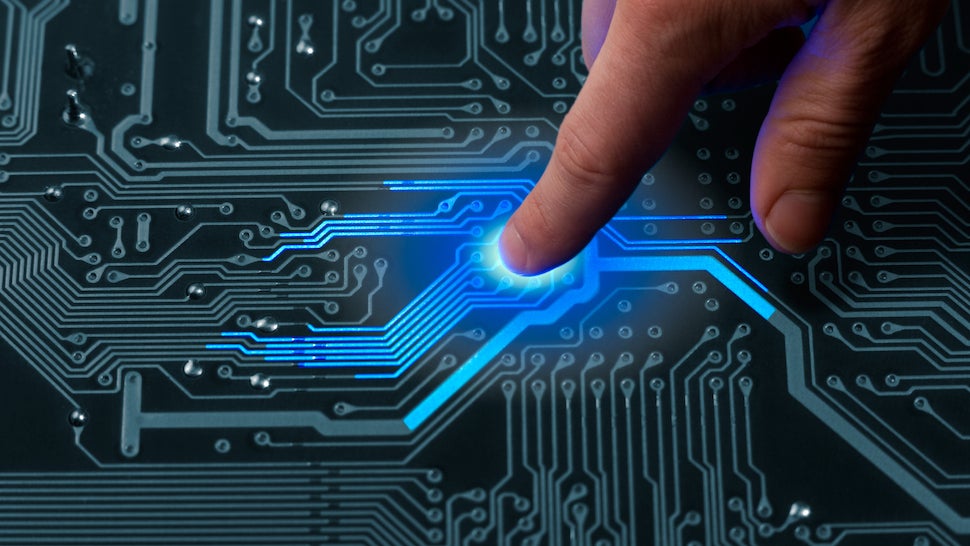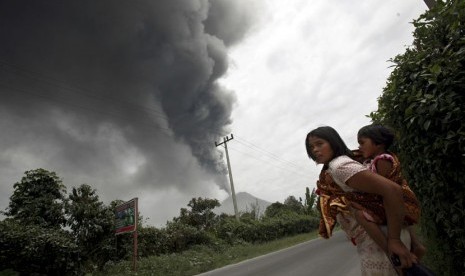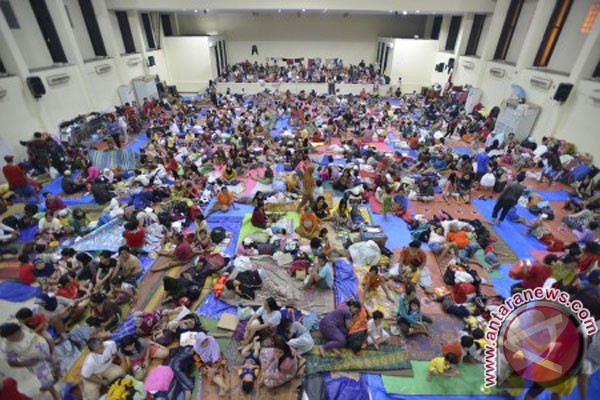Rabu, 29 Januari 2014
How Bioelectronics Promise A Future Cure For Cancer
When you think of cyborgs evolving a truth, you probably image Arnold
Schwarzenegger's blazing red eye from Terminator or the strong,
tight-lipped gaze of Robocop. But the future where man and appliance
converge won't just be constructed with nuts and bolts. It will be
constructed with biology.
NASA Radar Maps the Winter Pace of Iceland's Glaciers
NASA Radar Maps the Winter Pace of Iceland's Glaciers
A small part of the Hofsjökull ice hat in Iceland A small part of the
Hofsjökull ice cap in Iceland, which encompasses some glaciers. The fan
at top left is part of a glacier called Múlajökull. Image borrowing:
Caltech
A high-precision radar instrument from NASA's Jet Propulsion lab, Pasadena, Calif., left south California for Iceland today to create comprehensive maps of how glaciers move in the dead of winter. This will help scientists better understand some of the most basic methods engaged in melting glaciers, which are major suppliers to increasing sea levels.
The JPL-developed equipment, which soars on a NASA study airplane, departed from NASA's Dryden airplane Operations Facility in Palmdale, Calif. The trial is directed by assess Simons, a lecturer of geophysics at the California organisation of expertise in Pasadena, and Brent Minchew, a Caltech graduate student.
Simons and Minchew utilised the same airborne equipment in June 2012 to chart the summer flows of two Icelandic ice caps. The ice caps -- large localities of permanent snowfallfall and ice cover -- encompass multiple glaciers raging torrent in distinct directions and at distinct races.
throughout the 2012 campaign, surface ice on the glaciers was dissolving under the summer sun. Meltwater that trickles through the body of a glacier down to the bedrock underneath can leverage the speed at which the glacier flows. By mapping the same ice caps now, in winter, when the exterior remains frozen all day, and then matching the winter and summer velocities, the researchers will be adept to isolate the consequences of meltwater.
"That's a demanding subject," said Minchew. "Our comprehending of the consequences of meltwater on glacier flow is by no means entire. Even the most complicated ice sheet forms likely are not apprehending all of the salient processes."
Using NASA's C-20A airborne research airplane and support crew, the investigators will make four flights from Keflavik worldwide aerodrome beside Reykjavik, Iceland, between Jan. 30 and Feb. 6 throughout the couple of Arctic daylight hours. Each air travel follows accurately the same perplexing route as flown in 2012. The crisscrossing flight legs permit the JPL-developed instrument, called the Uninhabited Aerial Vehicle Synthetic Aperture Radar (UAVSAR), to chart the full span of both ice caps from multiple twists to capture flows in every main heading. The action of the ice between one flight and the next permits scientists to calculate flow races. "The UAVSAR gives us an entire, relentless map of how every location on the ice cap is moving," Simons said.
The two ice caps, called Hofsjökull and Langjökull, are perfect natural laboratories for this trial, according to Simons. They're somewhat uncomplicated and little sufficient that the scientists can readily use the facts and figures from these trials in computer forms of glacier flow without requiring a supercomputer. Langjökull, the bigger of the two, covers about 360 square miles (950 rectangle kilometers); for evaluation, the biggest ice hat in Iceland, Vatnajökull, is more than 3,100 rectangle miles (8,000 rectangle kilometers).
An even stronger motivation, Simons said, is that "we are benefiting from a huge allowance of work on these glaciers that's currently been finished by a group of internationally identified glaciologists in Iceland. The glaciers are in their backyard, and they've been studying them for years. They've currently mapped the ice-rock interface at the base of the glacier, for demonstration. We've had nothing but support and support from them."
For more information on UAVSAR, visit: http://uavsar.jpl.nasa.gov.
Caltech organises JPL for NASA.
NASA monitors Earth's crucial signs from land, air and space with a fleet of satellites and determined airborne and ground-based fact crusades. NASA evolves new ways to observe and study Earth's interconnected natural schemes with long-term facts and figures notes and computer investigation tools to better glimpse how our planet is altering. The bureau shares this exclusive information with the international community and works with institutions in the United States and round the world that contribute to comprehending and protecting our dwelling planet.
For more information about NASA's soil research undertakings in 2014, visit: http://www.nasa.gov
A high-precision radar instrument from NASA's Jet Propulsion lab, Pasadena, Calif., left south California for Iceland today to create comprehensive maps of how glaciers move in the dead of winter. This will help scientists better understand some of the most basic methods engaged in melting glaciers, which are major suppliers to increasing sea levels.
The JPL-developed equipment, which soars on a NASA study airplane, departed from NASA's Dryden airplane Operations Facility in Palmdale, Calif. The trial is directed by assess Simons, a lecturer of geophysics at the California organisation of expertise in Pasadena, and Brent Minchew, a Caltech graduate student.
Simons and Minchew utilised the same airborne equipment in June 2012 to chart the summer flows of two Icelandic ice caps. The ice caps -- large localities of permanent snowfallfall and ice cover -- encompass multiple glaciers raging torrent in distinct directions and at distinct races.
throughout the 2012 campaign, surface ice on the glaciers was dissolving under the summer sun. Meltwater that trickles through the body of a glacier down to the bedrock underneath can leverage the speed at which the glacier flows. By mapping the same ice caps now, in winter, when the exterior remains frozen all day, and then matching the winter and summer velocities, the researchers will be adept to isolate the consequences of meltwater.
"That's a demanding subject," said Minchew. "Our comprehending of the consequences of meltwater on glacier flow is by no means entire. Even the most complicated ice sheet forms likely are not apprehending all of the salient processes."
Using NASA's C-20A airborne research airplane and support crew, the investigators will make four flights from Keflavik worldwide aerodrome beside Reykjavik, Iceland, between Jan. 30 and Feb. 6 throughout the couple of Arctic daylight hours. Each air travel follows accurately the same perplexing route as flown in 2012. The crisscrossing flight legs permit the JPL-developed instrument, called the Uninhabited Aerial Vehicle Synthetic Aperture Radar (UAVSAR), to chart the full span of both ice caps from multiple twists to capture flows in every main heading. The action of the ice between one flight and the next permits scientists to calculate flow races. "The UAVSAR gives us an entire, relentless map of how every location on the ice cap is moving," Simons said.
The two ice caps, called Hofsjökull and Langjökull, are perfect natural laboratories for this trial, according to Simons. They're somewhat uncomplicated and little sufficient that the scientists can readily use the facts and figures from these trials in computer forms of glacier flow without requiring a supercomputer. Langjökull, the bigger of the two, covers about 360 square miles (950 rectangle kilometers); for evaluation, the biggest ice hat in Iceland, Vatnajökull, is more than 3,100 rectangle miles (8,000 rectangle kilometers).
An even stronger motivation, Simons said, is that "we are benefiting from a huge allowance of work on these glaciers that's currently been finished by a group of internationally identified glaciologists in Iceland. The glaciers are in their backyard, and they've been studying them for years. They've currently mapped the ice-rock interface at the base of the glacier, for demonstration. We've had nothing but support and support from them."
For more information on UAVSAR, visit: http://uavsar.jpl.nasa.gov.
Caltech organises JPL for NASA.
NASA monitors Earth's crucial signs from land, air and space with a fleet of satellites and determined airborne and ground-based fact crusades. NASA evolves new ways to observe and study Earth's interconnected natural schemes with long-term facts and figures notes and computer investigation tools to better glimpse how our planet is altering. The bureau shares this exclusive information with the international community and works with institutions in the United States and round the world that contribute to comprehending and protecting our dwelling planet.
For more information about NASA's soil research undertakings in 2014, visit: http://www.nasa.gov
http://software-aplikasi-android.blogspot.com//earthrightnow.
http://lowongan-kerja-luar-negri.blogspot.com/
Selasa, 28 Januari 2014
Apple be utilising sapphire glass
 Could apple be utilising sapphire glass for a solar-charging iPhone 6 screen?
Could apple be utilising sapphire glass for a solar-charging iPhone 6 screen?There’s been a allotment of talk about sapphire glass since apple CEO Tim prepare food sat down for an interview with ABC report last week. But apart from affirming that a new constructing vegetation the company bought in Mesa, Arizona last year will be used to make sapphire glass, no other minutia were revealed. Seeking Alpha analyst Matt Margolis has a attractive intriguing idea, though: He conceives Apple might be inscribing solar panels inside sapphire glass partitions for the next iPhone.
When you look at a lot of latest report about the business, this concept really makes a good deal of sense. For starters, Apple has filed solar patents that will permit the company to power devices through solar units. The company furthermore hired a thin films technician to “assist in the development and refinement of thin films technologies applicable to electrical devices systems.”
Apple then signed a $578 million contract with GT sophisticated Technologies, which was just confirmed to be for sapphire glass in the aforementioned ABC News interview. The business furthermore broadcast plans to spend $10.5 billion in 2014, on new output expertise encompassing robots and lasers. The company furthermore posted job listings for constructing design engineers, with quotations to solar cells and lasers in the job description. And it was just described that Apple constructing partner Foxconn lately assembled at least 100 prototype units of the next iPhone with sapphire exhibitions.
Apple’s solar farm next to its data center in Maiden, North Carolina
In supplement to all of this, Margolis notes that sapphire constructor GT has been able to considerably decrease the cost of sapphire glass, from $13-18 to just $3-5 per computer display. That makes it a financially viable alternative to Corning’s Gorilla Glass, which charges $3 per screen.
Of course, no one of this is a sure wager that apple fruit is really designing to make a move towards sapphire partitions or solar ascribing, but the pieces of the puzzle do fit together pretty well. The business is no stranger to the advantages of solar energy, with two solar farms and one fuel cell ranch beside its facts and figures center in North Carolina. And solar ascribing would be a gigantic step ahead for mobile apparatus, which only consume more and more electric electric battery life as they become larger and more powerful. Then afresh, a solar section the dimensions of a teleteletelephone screen wouldn’t generate all that much power, and I’m not sure apple fruit would proceed down this route unless it supplied a discernable benefit.
Minggu, 26 Januari 2014
Egyptians mark anniversary
CAIRO — On the third celebration of the uprising that promised to free Egypt from autocratic direct, thousands of demonstrators rallied in the capital Saturday to display support for the military number who overthrew the country’s first democratically voted into office leader.
competitor groups of demonstrators across the homeland were contacted with dangerous force. Clashes between policeman and anti-coup protesters aligned with Mohamed Morsi — and in a few cases, with liberal anti-military protesters — left 29 dead and almost 170 injured, according to the wellbeing Ministry, a day after six persons were killed in a string of attacks on security goals in Cairo. Twenty-six of the killings were in greater Cairo, the ministry said.
Morsi’s supporters in the Anti-Coup Alliance, an Islamist coalition, said at nightfall that 40 people had been killed nationwide. The wellbeing Ministry issues only the tally of bodies obtained by government hospital morgues, while activist tolls are often drawn from area clinics and family members.
previous in the day, supporters of Egypt’s infantry commander, Gen. Abdel Fatah al-Sissi, accumulated in a firmly protected Tahrir rectangle, the epicenter of the pro-democracy revolt that overthrew strongman Hosni Mubarak in 2011, to chant pro-military and nationalist slogans and advocate Sissi, the man who led the July coup that ousted Morsi, to run for president. The view mismatched harshly with the pluralistic air of the 2011 uprising, in which liberal youth activists, Islamists and others joined hands to call for Mubarak’s ouster and popular reforms.
Gone were the tents and banners of the multitude of political parties and activist groups that have taken to the square over the past three years to converse about, contend for and voice their demands for Egypt’s political transition.
“There is no space for us,” said Marwan Yassin, a 23-year-old liberal activist from the seaboard city of Alexandria. Yassin took part in the rallies that commanded to Mubarak’s downfall, but he said that “the youth have no belief in the political process now.”
Nearly every banner in Tahrir Square on Saturday unexciting Sissi’s face. Even the somewhat few posters with the titles of political parties, such as the liberal al-Wafd, were paired with the general’s face. Patriotic melodies blared from a stage, and military helicopters enencircled overhead. State TV aired footage of pro-military Egyptians promenading in cities over the homeland.
“It’s not their right” to be here, Hani Mahfouz, a video theater manager, said of Morsi’s backers in the Muslim Brotherhood and the liberal and leftist assemblies that spearheaded the 2011 protests but were visibly missing from Tahrir Square on Saturday. “They are the political front for terrorism,” he said of the activists, numerous of who have been jailed under the new military-backed government after disputing constrained freedoms.
“This ‘military direct’ [phrase] that they use is offensive,” he supplemented, mentioning to activist chants. “Our infantry is the best in the world.”
The few sizable anti-coup demonstrations that materialized across the capital Saturday were contacted almost instantly with force. policeman discharged live ammunition at anti-government demonstrators on the outskirts of Tahrir rectangle and in other localities of the town.
In the capital’s Dokki neighborhood, policemanmanman in very dark ski masks and bulletproof vests discharged volleys of tear gas and bullets into an anti-coup march, as spectators barracked them on. Swarms of young men emerged to be aiding the police, dragging other juvenile men — evidently from the other edge — back to policemanmanman lines.
“I didn’t do anything,” screamed one young man as he was pulled away by other ones in civilian apparel. Bystanders there and in other components of the capital said there had been swaps of gunfire between policemanman and Brotherhood protesters.
An central Ministry authorized said at least 350 people were apprehended nationwide.
Also Saturday, militants launched three attacks on government security goals, including a car bombing directed at a central security force barracks in the town of Suez, in Egypt’s crucial canal zone.
The militant group Ansar Bayt al-Maqdis asserted responsibility for the downing of a infantry helicopter in the Sinai Peninsula on Saturday after noon. The statement issued to jihadist forums said the group’s fighters discharged a surface-to-air missile at the helicopter, in what would be the first known deployment of the shoulder-fired tools for fighting by extremists conducting an insurgency against security forces in the Sinai desert.
localized media furthermore described that a surface-to-air missile was utilised to bring down the aircraft, quoting security officials.
The fresh violence came a day after Ansar Bayt al-Maqdis asserted blame for Friday’s blasting device attacks in the heart of Cairo, including a mighty blast at the city’s police head office.
Did Apple deal 55 Million iPhones Last Quarter?
55 million. That's the number of iPhones analysts accept as true, on average, that Apple sold in its first quarter of 2014. That numerous iPhones sold would assess Apple's best quarterly smartphone sales ever.
Let's discover the significances: What would 55 million iPhones mean for apple ? And what's going by car its robust iPhone sales?
Looking at the figures
approximating Apple's iPhone sales is simpler than it utilised to be. After Apple modified the way it presents guidance to a much more very sensible (and accurate) procedure, analysts' consensus estimates have been closer to genuine outcomes. So, assuming these approximates are, indeed, equitably close to what apple will report when it provides first-quarter outcomes on Monday, how will 55 million iPhones affect Apple's results?
Assuming the average trading cost continues the same as last quarter, the iPhone segment could account for about $32 billion of Apple's income. founded on analyst approximates of $57.9 billion in total income for the quarter, thus, the iPhone could account for about 55% of Apple's peak line -- slightly below the 56% of income the segment accounted for in the year-ago quarter.
With iPhone sales identically as significant to outcomes and unit estimates for the quarter's sales 15% higher than the year-ago number, the iPhone may contribute more to Apple's base line than ever before. No wonder analysts, on mean, are approximating record EPS at $14.32. Though $14.32 in EPS is only 3.7% higher than the year-ago quarter, the gain on the base line will be Apple's first in four quarters.
Where is all this growth coming from?
granted all the contradictory Apple headlines highlighting its dwindling international market share, it would be easy to assume that the business isn't growing any more. But that's just not the case. So how is apple still growing regardless of intensifying affray? The growth can be explained in two points.
1. Apple's profiting market share in the joined States. In the U.S., Apple's biggest market, Apple is doing exceedingly well. In detail, iPhone ownership in the U.S. is up seven percentage points in the fourth quarter of 2013 from the year-ago quarter, according to NPD.
2. apple is benefiting from general smartphone market growth. regardless of apple dwindling market share overseas as lower-cost Android apparatus make outsized profits in market share in many markets, Apple is still benefiting from the market's general growth.
Is this the starting of more development for apple ?
With analysts predicting development in Apple's earnings per share on the strength of record iPhone sales, can investors anticipate more development from Apple in the future?
It's definitely likely. There's likely still plenty of development ahead for Apple's iPhone and iPad segments. IDC pegs its estimates for annualized development in smartphone and tablet shipments between 2013 and 2017 at about 15%. really, the mean analyst estimate on Yahoo! Finance for Apple's EPS development next year is 10%. Looking out over the next five years, the outlook is even more bullish: Analysts anticipate EPS growth of about 15% per annum.
If apple is selling record iPhones, reporting record income, and growing its bottom line, does a cautious valuation of 13.8 times profits make sense?
What do you believe? Will Apple sell 55 million iPhones in Q1?
Looking for worth in a pricey market? Try these bonus supplies
One of the soiled secrets that few investment professionals will in an open way accept is that bonus stocks as a assembly handily outperform their non-dividend-paying brethren. although, knowing this is only half the assault. The other half is recognising which dividend supplies in particular are the best. With this in brain, our top analysts put simultaneously a free register of nine high-yielding stocks that should be in every earnings investor's portfolio. To discover the persona of these stocks instantly and for free, all you have to do is bang here now.
The item Did Apple deal 55 Million iPhones Last Quarter? initially appeared on Fool.com.
Fool supplier Daniel Sparks owns portions of apple . The Motley Fool suggests and owns portions of apple . Try any of our Foolish newsletter services free for 30 days. We Fools don't all hold the same opinions, but we all accept as true that contemplating a diverse range of insights makes us better investors. The Motley Fool has a revelation policy.
55 million. That's the number of iPhones analysts accept as true, on average, that Apple sold in its first quarter of 2014. That numerous iPhones sold would assess Apple's best quarterly smartphone sales ever.
Let's discover the significances: What would 55 million iPhones mean for apple ? And what's going by car its robust iPhone sales?
Looking at the figures
approximating Apple's iPhone sales is simpler than it utilised to be. After Apple modified the way it presents guidance to a much more very sensible (and accurate) procedure, analysts' consensus estimates have been closer to genuine outcomes. So, assuming these approximates are, indeed, equitably close to what apple will report when it provides first-quarter outcomes on Monday, how will 55 million iPhones affect Apple's results?
Assuming the average trading cost continues the same as last quarter, the iPhone segment could account for about $32 billion of Apple's income. founded on analyst approximates of $57.9 billion in total income for the quarter, thus, the iPhone could account for about 55% of Apple's peak line -- slightly below the 56% of income the segment accounted for in the year-ago quarter.
With iPhone sales identically as significant to outcomes and unit estimates for the quarter's sales 15% higher than the year-ago number, the iPhone may contribute more to Apple's base line than ever before. No wonder analysts, on mean, are approximating record EPS at $14.32. Though $14.32 in EPS is only 3.7% higher than the year-ago quarter, the gain on the base line will be Apple's first in four quarters.
Where is all this growth coming from?
granted all the contradictory Apple headlines highlighting its dwindling international market share, it would be easy to assume that the business isn't growing any more. But that's just not the case. So how is apple still growing regardless of intensifying affray? The growth can be explained in two points.
1. Apple's profiting market share in the joined States. In the U.S., Apple's biggest market, Apple is doing exceedingly well. In detail, iPhone ownership in the U.S. is up seven percentage points in the fourth quarter of 2013 from the year-ago quarter, according to NPD.
2. apple is benefiting from general smartphone market growth. regardless of apple dwindling market share overseas as lower-cost Android apparatus make outsized profits in market share in many markets, Apple is still benefiting from the market's general growth.
Is this the starting of more development for apple ?
With analysts predicting development in Apple's earnings per share on the strength of record iPhone sales, can investors anticipate more development from Apple in the future?
It's definitely likely. There's likely still plenty of development ahead for Apple's iPhone and iPad segments. IDC pegs its estimates for annualized development in smartphone and tablet shipments between 2013 and 2017 at about 15%. really, the mean analyst estimate on Yahoo! Finance for Apple's EPS development next year is 10%. Looking out over the next five years, the outlook is even more bullish: Analysts anticipate EPS growth of about 15% per annum.
If apple is selling record iPhones, reporting record income, and growing its bottom line, does a cautious valuation of 13.8 times profits make sense?
What do you believe? Will Apple sell 55 million iPhones in Q1?
Looking for worth in a pricey market? Try these bonus supplies
One of the soiled secrets that few investment professionals will in an open way accept is that bonus stocks as a assembly handily outperform their non-dividend-paying brethren. although, knowing this is only half the assault. The other half is recognising which dividend supplies in particular are the best. With this in brain, our top analysts put simultaneously a free register of nine high-yielding stocks that should be in every earnings investor's portfolio. To discover the persona of these stocks instantly and for free, all you have to do is bang here now.
The item Did Apple deal 55 Million iPhones Last Quarter? initially appeared on Fool.com.
Fool supplier Daniel Sparks owns portions of apple . The Motley Fool suggests and owns portions of apple . Try any of our Foolish newsletter services free for 30 days. We Fools don't all hold the same opinions, but we all accept as true that contemplating a diverse range of insights makes us better investors. The Motley Fool has a revelation policy.
Kamis, 23 Januari 2014
BCA Counter Exchange Rate
Fee & Limit
 Currency Rate
Currency Rate
Currency |
| USD |
| SGD |
| EUR |
| AUD |
| DKK |
| SEK |
| CAD |
| CHF |
| NZD |
| GBP |
| HKD |
| JPY |
| SAR |
| CNY |
| e-Rate
23 Jan 2014 / 16:23 WIB
|
|
| Sell | Buy |
| 12195.00 | 12155.00 |
| 9525.41 | 9485.41 |
| 16641.84 | 16561.84 |
| 10744.75 | 10674.75 |
| 2259.88 | 2189.88 |
| 1923.79 | 1853.79 |
| 10944.51 | 10874.51 |
| 13513.37 | 13443.37 |
| 10144.52 | 10074.52 |
| 20262.68 | 20182.68 |
| 1579.28 | 1559.28 |
| 118.24 | 115.24 |
| 3281.34 | 3211.34 |
| 2031.84 | 1991.84 |
| TT Counter
23 Jan 2014 / 16:21 WIB
|
|
| Sell | Buy |
| 12300.00 | 12000.00 |
| 9535.70 | 9435.70 |
| 16796.40 | 16351.40 |
| 10843.50 | 10531.50 |
| 2267.85 | 2185.95 |
| 1926.50 | 1853.80 |
| 11040.85 | 10721.85 |
| 13648.85 | 13270.85 |
| 10245.45 | 9924.45 |
| 20469.70 | 19898.70 |
| 1580.50 | 1554.10 |
| 118.48 | 114.57 |
| 3291.00 | 3189.00 |
| 2036.60 | 1979.30 |
| Bank Notes
23 Jan 2014 / 08:15 WIB
|
|
| Sell | Buy |
| 12300.00 | 12000.00 |
| 9611.00 | 9362.00 |
| 16672.00 | 16218.00 |
| 10892.00 | 10571.00 |
| 2250.00 | 2146.00 |
| 1909.00 | 1808.00 |
| 11090.00 | 10752.00 |
| 13490.00 | 13105.00 |
| 10211.00 | 9903.00 |
| 20402.00 | 19830.00 |
| 1593.00 | 1536.00 |
| 117.74 | 114.20 |
| 3284.00 | 3049.00 |
| 2038.00 | 1967.00 |
Notes :
e-Rate is used for transaction through e-Channel
*) Call the nearest BCA branch to get information about the exchange rate for a specific value.
Exchange rate can change without prior notification.
Foreign Exchange Rates as of 23 January 2014
| Foreign Exchange Rates as of 23 January 2014 |
|||||||||||||||||||||||||||||||||||||||||||||||||||||||||||||||||||||||||||||||||||||||||||||||||||||||||||||||||||||
| Weighted-average Interbank Exchange Rate = 32.969 Baht/US Dollar | |||||||||||||||||||||||||||||||||||||||||||||||||||||||||||||||||||||||||||||||||||||||||||||||||||||||||||||||||||||
|
1. Average Counter Rates Quoted by Commercial Banks |
|||||||||||||||||||||||||||||||||||||||||||||||||||||||||||||||||||||||||||||||||||||||||||||||||||||||||||||||||||||
| ( Baht / 1 Unit of Foreign Currency ) | |||||||||||||||||||||||||||||||||||||||||||||||||||||||||||||||||||||||||||||||||||||||||||||||||||||||||||||||||||||
| |||||||||||||||||||||||||||||||||||||||||||||||||||||||||||||||||||||||||||||||||||||||||||||||||||||||||||||||||||||
2. Foreign Exchange Rates (THOMSON REUTERS) with Bangkok Market Crossing | |||||||||||||||||||||||||||||||||||||||||||||||||||||||||||||||||||||||||||||||||||||||||||||||||||||||||||||||||||||
| |||||||||||||||||||||||||||||||||||||||||||||||||||||||||||||||||||||||||||||||||||||||||||||||||||||||||||||||||||||
Rabu, 22 Januari 2014
Mount Sinabung @ Tanah Karo ; Sumatera Utara ; Indonesia ....erupted....Pray for Sinabung....
Images Mount Sinabung erupted
( Pray for Sinabung )
images refugee evacuation of residents around Mount Sinabung
( Pray for Sinabung )
Failed to Satisfy Investors Issuer 's performance , Wall Street Mixed
New York - Wall Street stocks ended mixed with the S & P 500 fell into the red zone . Performance of the issuer fails to satisfy investors , causing a sell-off before the close of trading .
Dow Jones and S & P 500 returned dututup in the red zone , but the Nasdaq rose thanks to gains in capable BlackBerry . IBM Saha became ballast exchange .
" We see a significant decline in the performance of listed companies last year , but there are also some that can provide satisfactory kinrja , " said Kristina Hooper , head of portfolio strategy of Allianz Global Investors in New York , as quoted by Reuters on Thursday ( 23/1 / 2014 ) .
" Issuer 's performance as kesehata describe economic conditions , which is why there are a lot of disappointment in the market , " he explained .
New 16 % S & P 500 companies that have reported financial results , as many as 61% of them exceeded analysts' predictions . This figure is still below the range of the previous quarter to reach 67 % . When viewed comparison , every eight underperforming companies then there is a positive one .
At the close of trading on Thursday , Dow Jones industrial average fell 41.10 points ( 0.25 %) to 16373.34 . The broader Standard & Poor's 500 index edged up 1.06 points ( 0.06 %) to 1844.86 . The Nasdaq Composite Index increased 17.24 points ( 0.41 % ) to a level of 4243.00
Dow Jones and S & P 500 returned dututup in the red zone , but the Nasdaq rose thanks to gains in capable BlackBerry . IBM Saha became ballast exchange .
" We see a significant decline in the performance of listed companies last year , but there are also some that can provide satisfactory kinrja , " said Kristina Hooper , head of portfolio strategy of Allianz Global Investors in New York , as quoted by Reuters on Thursday ( 23/1 / 2014 ) .
" Issuer 's performance as kesehata describe economic conditions , which is why there are a lot of disappointment in the market , " he explained .
New 16 % S & P 500 companies that have reported financial results , as many as 61% of them exceeded analysts' predictions . This figure is still below the range of the previous quarter to reach 67 % . When viewed comparison , every eight underperforming companies then there is a positive one .
At the close of trading on Thursday , Dow Jones industrial average fell 41.10 points ( 0.25 %) to 16373.34 . The broader Standard & Poor's 500 index edged up 1.06 points ( 0.06 %) to 1844.86 . The Nasdaq Composite Index increased 17.24 points ( 0.41 % ) to a level of 4243.00
Disaster in Serang as 2 Children Die in Bridge Collapse, Many Missing
Disaster in Serang as 2 Children Die in Bridge Collapse, Many Missing
Serang, Banten. At least two people died and many were missing after a bridge collapsed in Serang on Tuesday afternoon as dozens of people, many of them children, were watching the high water level in the Cibanten River.
“We’re still searching [for victims],” head of the Banten Disaster and Mitigation Agency (BPBD) Ino Rawita said on Tuesday, as quoted by state run Antara news agency.
Scores of people were watching the river, which was experiencing high water levels as the rainy season continued to peak, when one of the supports broke and the bridge collapsed. National Disaster and Mitigation Agency (BNPB) Sutopo Purwo Nugroho identified the two dead children as Firdaus, 14 and Rahman, 9.
Around 30 people were rescued. It was not clear on Wednesday how many people may had been killed.
I know that Banten government can afford the bridge, but they don’t care
Sutopo said 12 people were still missing, although this figure could well change, and that the search would be resumed on Wednesday.
Banten Legislative Council (DPRD Banten) member Ayib Najib said the DPRD had told both the Serang and Banten governments to build a permanent bridge in place of the suspension structure, but that the request had fallen on deaf ears.
Banten Governor Ratu Atut Chosiyah was arrested by the Corruption Eradication Commission (KPK) at the end of 2013 and has been charged by the anti-graft authority with appropriating the provincial budget for her own ends.
“Almost every recess, I told the government about it,” Ayib said. “As for us, it is not a problem who builds the bridge, whether it is the Banten or Serang government. But none of them responded.
“Why is it so difficult to build this kind of facility for residents?” he said. “I know that Banten government can afford the bridge, but they don’t care.”
Langganan:
Komentar (Atom)






























